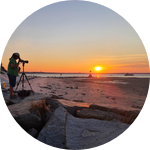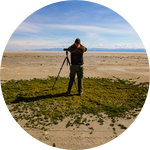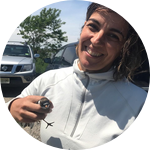Project Results
Thank you to all of the folks who helped make our Experiment campaign a great success. We are so grateful for the 99 donors who contributed. Thanks to you, we received additional funds from the Environmental Citizen Science Challenge grant! We wanted to share our March newsletter as a report of our results in 2020. In future newsletters, we look forward to sharing outcomes in 2021 that came about directly from your donations. Thank you!
https://www.manomet.org/wp-content/uploads/2021/03/ISSnewsMar2021Eng.pdf
About This Project
Manomet's International Shorebird Survey (ISS) is a Citizen Science project designed to gather information on shorebirds and the habitats they use. Hundreds of shorebird enthusiasts across the Western Hemisphere conduct surveys during migration. Data collected are fundamental for population size and trend analyses, documenting wide-scale shorebird population declines. Our goal is to increase the number of volunteers submitting surveys by 20%, leading to better data and analysis.
Ask the Scientists
Join The DiscussionWhat is the context of this research?
Shorebirds can nest in vast, inaccessible tundra landscapes, migrate incredible distances, and disperse into frequently remote non-breeding areas for much of the year. How can anyone have a reasonable guess of the number of individuals in these long-distance species? How do we understand how well each species does over time? How do we find out where the most important places are for these birds that fly between continents? Brian Harrington, a shorebird scientist at Manomet, contemplated these questions in the early 1970s. His answer was to establish one of the longest-running citizen science projects in the world, the International Shorebird Survey, in which volunteers throughout the Western Hemisphere capture shorebird knowledge during migration.
What is the significance of this project?
Today, shorebirds are undergoing one of the most dramatic declines of any bird group worldwide. Recent studies show that we have lost more than one-third of all coastal shorebirds since 1970. Data collected through the work of dedicated ISS volunteers conducting field surveys during spring and fall migrations, has proven pivotal to a wide range of conservation planning endeavors across the hemisphere. ISS data have also been extensively used to document major shorebird migration staging areas throughout the Western Hemisphere and to identify and process site nominations for the Western Hemisphere Shorebird Reserve Network. Most recently ISS data contributed to the Cornell University and American Bird Conservancy's 3 Billion Birds project.
What are the goals of the project?
By increasing the number of volunteers submitting ISS surveys by 20%, focusing on important shorebird areas which currently lack coverage, our goal is to increase knowledge of shorebird populations trends and identify key shorebird sites throughout the Western Hemisphere. Our secondary goal is to build a shorebird constituency with enthusiasts who will care and advocate for shorebirds. To accomplish this, we will recruit, train, and support ISS contributors. We will make sure they have the resources, knowledge, and skills they need to complete their counts via training tools and direct communication. We will continue to improve the ISS Mapping Tool which provides data storage, display, and preliminary analysis for shorebird scientists, partners, and ISS contributors.
Budget
1 A training video will share the hows and what of ISS and would help us recruit, train, and retain shorebird enthusiasts across the hemisphere, so they can add to our shorebird database. Since about half of our contributors are in Central and South America we need three versions, English, Spanish, and Portuguese.
2 One of our largest challenges at ISS has been the lack of high quality optics in some parts of the hemisphere. It is very difficult to count shorebirds without them. We want to establish a small grants process to help get vital optics into the hands of citizen scientists in Central and South America.
3 Our online ISS Mapping Tool provides data storage, display, and preliminary analysis for shorebird scientists and partners. We also want our volunteers to be able to see their data and how it contributes to shorebird knowledge. We will use funds to add new features.
4 Conduct a survey of ISS contributors to understand barriers encountered to volunteering.
Endorsed by
 Project Timeline
Project Timeline
Our newsletter wings to our citizen scientists in February and August, so our Volunteer Survey will be completed by mid February. Work on the training videos will be completed by April. And ISS Mapping Tool upgrades will be completed by the end of June.
Nov 30, 2020
Project Launched
Dec 03, 2020
Project Launched
Jan 18, 2021
Solicit optics requests from current volunteers
Feb 15, 2021
Volunteer Survey sent out
Mar 01, 2021
Identify volunteers to receive optics grants
Meet the Team
Affiliates
Team Bio
With a deep history in landbird and shorebird research and recovery, Manomet supports wildlife and people by engaging communities and partners to reduce pressure on habitats and mitigate climate change impacts. It addresses these challenges by understanding the science of our natural world and working with partners—including communities, producers, companies, and governments—to develop effective management practices.
Lisa Schibley
Lisa joined the Shorebird Recovery Program at Manomet in 2008 and is currently the North American coordinator for the International Shorebird Survey. She develops and maintains the online ISS mapping tool, creates reports for Manomet scientists and partners, recruits and engages ISS volunteers through social media and newsletters, and finds creative ways to tell shorebird stories using ISS data.
Arne Lesterhuis
Manomet is all about working towards a sustainable world through engaging with people and effecting a meaningful change in key natural systems that those people depend on. The identification of important sites for shorebirds, a key part of my job, and working with local people to protect these is a clear example of reaching that goal. Data analysis of gathered shorebird data by volunteers that I recruit for the International Shorebird Survey in Latin America and the Caribbean, help to evaluate our success in shorebird habitat conservation, but also provides a necessary basis for monitoring shorebird population trends.
Juliana Almeida
I have worked with shorebirds throughout the Western Hemisphere for more than 15 years. Increasing awareness, knowledge and engagement of the general public, bird lovers and researchers to improve shorebird conservation in Brazil has always been among my goals in life. Those have become goals of the Shorebird Conservation Program that I created and lead within SAVE Brasil.
Project Backers
- 99Backers
- 136%Funded
- $6,848Total Donations
- $62.88Average Donation






